Ultrasound Sensors for Process Monitoring in Injection Moulding
Abstract
1. Introduction
2. Properties of Ultrasound Wave Propagation
3. Conventional Ultrasonic Transducer (UT) Applications in the Injection Moulding Process
3.1. Application of Conventional Ultrasonic Probes at the Mould Insert and Barrel
3.2. Application of Conventional Ultrasonic Probes at the Barrel, Nozzle, and Tie Bars
4. High-Temperature Ultrasonic Transducers (HTUT) by Sol-Gel Technique
- The solution should be prepared, and the desired ceramic powder should be added to the solution and dispersed by a stirrer;
- The film should be deposited on the desired substrate by a coating process, and thermal treatment should be also applied;
- Repeated coating layers should be applied to reach the desired thickness;
- The film’s stability and properties should be characterised and the top electrode should be placed for electrical connection;
- The film should be electrically poled. Methods include DC Corona poling, high temperature corona poling and DC power.
4.1. Application of Sol-Gel Ultrasound Sensors in the Injection Moulding Process
4.1.1. Application of Sol-Gel Sensors on the Barrel and in Mould Inserts
- The longitudinal velocity increases under higher temperatures and higher injection speeds, because of the change of HDPE morphology with different process settings.
- As the injection speed increased, the longitudinal and shear ultrasonic velocities differed significantly.
- Comparison of the time delay in parallel and perpendicular directions to the melt flow indicated a higher storage modulus in the perpendicular direction. This was attributed to the formation of crystalline lamellae in the perpendicular direction, which was confirmed by Scanning Electron Microscopy.
4.1.2. Application Sol-Gel Ultrasonic Sensors at the Nozzle
| Sensor’s Type | Sensor Location | Investigated Process/Material Parameters | Reference |
|---|---|---|---|
| Conventional Ultrasonic Probe | 1. Gap formation | [24] | |
| 2. Contact time | [24] | ||
| 3. Timing of different process stages | [24,29,31] | ||
| Mould | 4. Part detachment | [29] | |
| 5. Solidification time in dynamic and static packing | [29] | ||
| 6. Melt Temperature | [34] | ||
| 7. Detection of crystalline & amorphous morphology | [29] | ||
| 8. Phase morphology of polymer blend | [29] | ||
| Barrel | 1. Melting behaviour | [32] | |
| Nozzle | 1. Timing of different stages | [28] | |
| 1. Unmelted granules | [22] | ||
| Screw | 2. Solid bed/ melt ratio | [22] | |
| 1. Clamping force | [36] | ||
| tie bar | 2. Cavity pressure | [27] | |
| Sol-gel Ultrasound Sensors | 1. Velocity of polymer melt during solidification | [50] | |
| Barrel | 2. Timing of different process stages | [4,50,53,54] | |
| 3. Polymer degradation | [51] | ||
| & | 4. Incomplete filling | [51] | |
| 5. shrinkage | [4] | ||
| Mould-insert | 6. Part detachment | [4] | |
| 7. Velocity of flow front | [53] | ||
| 8. Mould opening & closing time | [53] | ||
| 9. Effects of different process settings on morphology | [54] | ||
| 10. Storage modulus | [54] | ||
| 1. Screw movements | [56] | ||
| 2. Different stages of IM | [52,56] | ||
| Nozzle | 3. Static density | [55] | |
| 4. Flow speed | [55] | ||
| 5. Effect of feeding stage on the tensile properties of the part | [52] |
4.2. Overview of Materials for the Fabrication of Ultrasonic Sensors by Sol-Gel Technique
4.2.1. Lead-Based Sol-Gel Composites
4.2.2. Lead-Free Sol-Gel Composites
5. Discussion and Future Directions
6. Conclusions
Author Contributions
Funding
Institutional Review Board Statement
Informed Consent Statement
Data Availability Statement
Conflicts of Interest
References
- Kazmer, D.O. Injection Mold Design Engineering. In Injection Mold Design Engineering; Carl Hanser Verlag GmbH & Co. KG: München, Germany, 2007. [Google Scholar] [CrossRef]
- Rosato, D.V.; Rosato, M.G. Injection Molding Handbook; Springer: Boston, MA, USA, 2000; Chapter 3. [Google Scholar] [CrossRef]
- Pacher, G.A.; Berger, G.R.; Friesenbichler, W.; Gruber, D.P.; Macher, J. In-mold sensor concept to calculate process-specific rheological properties. AIP Conf. Proc. 2014, 1593, 179–182. [Google Scholar] [CrossRef]
- Ono, Y.; Whiteside, B.R.; Brown, E.C.; Kobayashi, M.; Cheng, C.C.; Jen, C.K.; Coates, P.D. Real-time process monitoring of micromoulding using integrated ultrasonic sensors. Trans. Inst. Meas. Control 2007, 29, 383–401. [Google Scholar] [CrossRef]
- Edwards, R.; Thomas, C. On-line measurement of polymer orientation using ultrasonic technology. Polym. Eng. Sci. 2001, 41, 1644–1653. [Google Scholar] [CrossRef]
- Praher, B.; Straka, K.; Steinbichler, G. An ultrasound-based system for temperature distribution measurements in injection moulding: System design, simulations and off-line test measurements in water. Meas. Sci. Technol. 2013, 24, 084004. [Google Scholar] [CrossRef]
- Fan, Z.; Gao, R.X.; Kazmer, D.O. Self-energized acoustic wireless sensor for pressure-temperature measurement in injection molding cavity. In Proceedings of the IEEE Sensors, Christchurch, New Zealand, 25–28 October 2009; pp. 65–68. [Google Scholar] [CrossRef]
- Ageyeva, T.; Horváth, S.; Kovács, J.G. In-mold sensors for injection molding: On theway to industry 4.0. Sensors 2019, 19, 3551. [Google Scholar] [CrossRef] [PubMed]
- Zhang, G.; Jiang, L.; Shen, K.; Guan, Q. The self-reinforcement of low density polyethylene by oscillating packing injection molding under low pressure. J. Appl. Polym. Sci. 1999, 71, 799–804. [Google Scholar] [CrossRef]
- Zhang, Q.; Wang, Y.; Fu, Q. Shear-induced change of exfoliation and orientation in polypropylene/montmorillonite nanocomposites. J. Polym. Sci. Part B Polym. Phys. 2002, 41, 1–10. [Google Scholar] [CrossRef]
- Na, B.; Zhang, Q.; Wang, Y.; Fu, Q. Orientation effects on the deformation and fracture properties of high-density polyethylene/ethylene vinyl acetate(HDPE/EVA) blends. Polym. Int. 2004, 53, 1078–1086. [Google Scholar] [CrossRef]
- Ozcelik, B.; Erzurumlu, T. Comparison of the warpage optimization in the plastic injection molding using ANOVA, neural network model and genetic algorithm. J. Mater. Process. Technol. 2006, 171, 437–445. [Google Scholar] [CrossRef]
- Jin, K.; Jeong, T.; Kim, T.; Kim, N.; Kim, B. Analysis and design for reducing residual stress and distortion after ejection of injection molded part with metal-insert. Int. J. Precis. Eng. Manuf. 2014, 15, 2533–2542. [Google Scholar] [CrossRef]
- Hentati, F.; Hadriche, I.; Masmoudi, N.; Bradai, C. Optimization of the injection molding process for the PC/ABS parts by integrating Taguchi approach and CAE simulation. Int. J. Adv. Manuf. Technol. 2019, 104, 4353–4363. [Google Scholar] [CrossRef]
- Oliaei, E.; Heidari, B.S.; Davachi, S.M.; Bahrami, M.; Davoodi, S.; Hejazi, I.; Seyfi, J. Warpage and Shrinkage Optimization of Injection-Molded Plastic Spoon Parts for Biodegradable Polymers Using Taguchi, ANOVA and Artificial Neural Network Methods. J. Mater. Sci. Technol. 2016, 32, 710–720. [Google Scholar] [CrossRef]
- Wang, J.; Mao, Q. Methodology Based on the PVT Behavior of Polymer for Injection Molding. Adv. Polym. Technol. 2012, 32, 474–485. [Google Scholar] [CrossRef]
- Manbachi, A.; Cobbold, R.S. Development and application of piezoelectric materials for ultrasound generation and detection. Ultrasound 2011, 19, 187–196. [Google Scholar] [CrossRef]
- He, B.; Yang, Y.; Zou, H.; Zhang, Q.; Fu, Q. Fast determination of phase inversion in polymer blends using ultrasonic technique. Polymer 2005, 46, 7624–7631. [Google Scholar] [CrossRef]
- Lionetto, F.; Maffezzoli, A. Polymer characterization by ultrasonic wave propagation. Adv. Polym. Technol. 2009, 27, 63–73. [Google Scholar] [CrossRef]
- Thurston, R. Wave Propagation in Fluids and Normal Solids. In Physical Acoustics; Academic Press: Cambridge, MA, USA, 1964; pp. 1–110. [Google Scholar] [CrossRef]
- Oakley, B.A.; Barber, G.; Worden, T.; Hanna, D. Ultrasonic Parameters as a Function of Absolute Hydrostatic Pressure. I. A Review of the Data for Organic Liquids. J. Phys. Chem. Ref. Data 2003, 32, 1501–1534. [Google Scholar] [CrossRef][Green Version]
- Praher, B.; Straka, K.; Usanovic, J.; Steinbichler, G. Ultrasound based monitoring of the injection moulding process—Methods, applications and limitations. AIP Conf. Proc. 2014, 1593, 159–162. [Google Scholar] [CrossRef]
- McSkimin, H. Ultrasonic Methods for Measuring the Mechanical Properties of Liquids and Solids. In Physical Acoustics; Elsevier: London, UK, 1964; pp. 271–334. [Google Scholar] [CrossRef]
- Wang, H.; Cao, B.; Jen, C.K.; Nguyen, K.T.; Viens, M. On-line ultrasonic monitoring of the injection molding process. Polym. Eng. Sci. 1997, 37, 363–376. [Google Scholar] [CrossRef]
- Hsu, N.N. Acoustical birefringence and the use of ultrasonic waves for experimental stress analysis. Exp. Mech. 1974, 14, 169–176. [Google Scholar] [CrossRef]
- Sayers, C.M. Ultrasonic velocities in anisotropic polycrystalline aggregates. J. Phys. D Appl. Phys. 1982, 15, 2157–2167. [Google Scholar] [CrossRef]
- Zhang, J.; Zhao, P.; Zhao, Y.; Huang, J.; Xia, N.; Fu, J. On-line measurement of cavity pressure during injection molding via ultrasonic investigation of tie bar. Sens. Actuators A Phys. 2019, 285, 118–126. [Google Scholar] [CrossRef]
- Brown, E.C.; Dawson, A.J.; Coates, P.D. Ultrasonic monitoring of nozzle and cavity during injection moulding. J. Reinf. Plast. Compos. 2002, 21, 441–450. [Google Scholar] [CrossRef]
- Michaeli, W.; Starke, C. Ultrasonic investigations of the thermoplastics injection moulding process. Polym. Test. 2005, 24, 205–209. [Google Scholar] [CrossRef]
- Menges, G. Werkstoffkunde Kunststoffe; Carl Hanser Verlag: München, Germany; Wien, Austria, 1990; p. 382. [Google Scholar]
- He, B.; Zhang, X.; Zhang, Q.; Fu, Q. Real-time ultrasonic monitoring of the injection-molding process. J. Appl. Polym. Sci. 2008, 107, 94–101. [Google Scholar] [CrossRef]
- Altmann, D.; Praher, B.; Steinbichler, G. Simulation of the melting behavior in an injection molding plasticizing unit as measured by pressure and ultrasound measurement technology. AIP Conf. Proc. 2019, 2055, 040003. [Google Scholar] [CrossRef]
- Tadmor, Z.; Gogos, C.G. Principles of polymer processing. Choice Rev. Online 2007, 44, 2729. [Google Scholar] [CrossRef]
- Zhao, P.; Ji, K.; Zhang, J.; Chen, Y.; Dong, Z.; Zheng, J.; Fu, J. In-situ ultrasonic measurement of molten polymers during injection molding. J. Mater. Process. Technol. 2021, 293, 117081. [Google Scholar] [CrossRef]
- Rochendi, A.D.; Kampono, I. Design and Build A Plastic Pellet Monitor System Prototype on An Injection Molding Plastic Storage Tank with The Blynk Application. Int. J. Adv. Technol. Mech. Mechatron. Mater. 2020, 1, 83–89. [Google Scholar] [CrossRef]
- Zhao, Y.; Zhao, P.; Zhang, J.; Huang, J.; Xia, N.; Fu, J. On-line measurement of clamping force for injection molding machine using ultrasonic technology. Ultrasonics 2019, 91, 170–179. [Google Scholar] [CrossRef]
- Xia, N.; Zhao, P.; Kuang, T.; Zhao, Y.; Zhang, J.; Fu, J. Nondestructive measurement of layer thickness in water-assisted coinjection-molded product by ultrasonic technology. J. Appl. Polym. Sci. 2018, 135, 2–9. [Google Scholar] [CrossRef]
- Zhao, P.; Zhao, Y.; Kharbas, H.; Zhang, J.; Wu, T.; Yang, W.; Fu, J.; Turng, L.S. In-situ ultrasonic characterization of microcellular injection molding. J. Mater. Process. Technol. 2019, 270, 254–264. [Google Scholar] [CrossRef]
- Rozgonyi, G.A.; Polito, W.J. Preparation of ZnO thin films by sputtering of the compound in oxygen and argon. Appl. Phys. Lett. 1966, 8, 220–221. [Google Scholar] [CrossRef]
- Chang, C.C.; Chen, K.H. Fabrication and characterization of PZT thin film ultrasonic devices. J. Chin. Inst. Eng. Trans. Chin. Inst. Eng. A/Chung-Kuo Kung Ch’eng Hsuch K’an 2000, 23, 179–184. [Google Scholar] [CrossRef]
- Taguchi, I.; Pignolet, A.; Wang, L.; Proctor, M.; Lévy, F.; Schmid, P.E. Raman scattering from PbTiO3 thin films prepared on silicon substrates by radio frequency sputtering and thermal treatment. J. Appl. Phys. 1993, 73, 394–399. [Google Scholar] [CrossRef]
- Boulos, M.I. RF induction plasma spraying: State-of-the-art review. J. Therm. Spray Technol. 1992, 1, 33–40. [Google Scholar] [CrossRef]
- Pierlot, C.; Pawlowski, L.; Bigan, M.; Chagnon, P. Design of experiments in thermal spraying: A review. Surf. Coat. Technol. 2008, 202, 4483–4490. [Google Scholar] [CrossRef]
- Reichelt, K.; Jiang, X. The preparation of thin films by physical vapour deposition methods. Thin Solid Films 1990, 191, 91–126. [Google Scholar] [CrossRef]
- Chang, C.C.; Chen, Y.E. Fabrication of high sensitivity ZnO thin film ultrasonic devices by electrochemical etch techniques. IEEE Trans. Ultrason. Ferroelectr. Freq. Control 1997, 44, 624–628. [Google Scholar] [CrossRef]
- Barrow, D.A.; Petroff, T.E.; Sayer, M. Thick ceramic coatings using a sol gel based ceramic-ceramic 0–3 composite. Surf. Coat. Technol. 1995, 76–77, 113–118. [Google Scholar] [CrossRef]
- Barrow, D.A.; Petroff, T.E.; Sayer, M. Method For Producing Thick Ceramic Films By a Sol Gel Coating Process. U.S. Patent 5,585, 17 December 1997. [Google Scholar]
- Shilpa, G.D.; Sreelakshmi, K.; Ananthaprasad, M.G. PZT thin film deposition techniques, properties and its application in ultrasonic MEMS sensors: A review. IOP Conf. Ser. Mater. Sci. Eng. 2016, 149, 012190. [Google Scholar] [CrossRef]
- Hara, T.; Furukawa, M.; Nozawa, S.; Nakatsuma, K.; Kobayashi, M. Polarity effect of corona discharge poling for sol-gel composite-based ultrasonic transducers. Jpn. J. Appl. Phys. 2020, 59. [Google Scholar] [CrossRef]
- Kobayashi, M.; Jen, C.K.; Corbeil, C.; Ono, Y.; Hébert, H.; Derdouri, A. High temperature ultrasonic transducers for monitoring of micro-molding. In Proceedings of the IEEE Ultrasonics Symposium, Honolulu, HI, USA, 5–8 October 2003; Volume 2, pp. 1119–1124. [Google Scholar] [CrossRef]
- Whiteside, B.R.; Brown, E.C.; Ono, Y.; Jen, C.K.; Coates, P.D. Real-time ultrasonic diagnosis of polymer degradation and filling incompleteness in micromoulding. Plast. Rubber Compos. 2005, 34, 387–392. [Google Scholar] [CrossRef]
- Cheng, C.C.; Wu, Y.L. Diagnosis of multi-stage injection molding process by ultrasonic technology at a T-shape extension nozzle. J. Mater. Process. Technol. 2020, 282, 116650. [Google Scholar] [CrossRef]
- Kobayashi, M.; Ono, Y.; Jen, C.K.; Cheng, C.C. High-temperature piezoelectric film ultrasonic transducers by a sol-gel spray technique and their application to process monitoring of polymer injection molding. IEEE Sens. J. 2006, 6, 55–62. [Google Scholar] [CrossRef]
- Zhao, L.; Lai, Y.; Pei, C.; Jen, C.K.; Wu, K.D. Real-time diagnosing polymer processing in injection molding using ultrasound. J. Appl. Polym. Sci. 2012, 126, 2059–2066. [Google Scholar] [CrossRef]
- Wu, Y.L.; Yang, C.H.; Cheng, C.C.; Kobayashi, M. Novel real-time diagnostic of injection molding process at nozzle by high-temperature ultrasonic transducer. In Proceedings of the 2015 IEEE International Ultrasonics Symposium (IUS), Taipei, Taiwan, 21–24 October 2015; Volume 2, pp. 3–5. [Google Scholar] [CrossRef]
- Wu, Y.L.; Cheng, C.C.; Kobayashi, M.; Yang, C.H. Novel design of extension nozzle and its application on real-time injection molding process diagnosed by ultrasound. Sens. Actuators A Phys. 2017, 263, 430–438. [Google Scholar] [CrossRef]
- Kobayashi, M.; Olding, T.R.; Sayer, M.; Jen, C.K. Piezoelectric thick film ultrasonic transducers fabricated by a sol-gel spray technique. Ultrasonics 2002, 39, 675–680. [Google Scholar] [CrossRef]
- Ono, Y.; Jen, C.K.; Cheng, C.C.; Kobayashi, M. Real-time monitoring of injection molding for microfluidic devices using ultrasound. Polym. Eng. Sci. 2005, 45, 606–612. [Google Scholar] [CrossRef]
- Lukacs, M.; Sayer, M.; Foster, S. Single element and linear array PZT ultrasound biomicroscopy transducers. In Proceedings of the 1997 IEEE Ultrasonics Symposium Proceedings, An International Symposium (Cat. No. 97CH36118), Toronto, ON, Canada, 5–8 October 1997; Volume 2, pp. 1709–1712. [Google Scholar] [CrossRef]
- Lukacs, M.; Sayer, M.; Foster, S. High frequency ultrasonics using PZT sol gel composites. Integr. Ferroelectr. 1999, 24, 95–106. [Google Scholar] [CrossRef]
- Kobayashi, M.; Jen, C.K.; Bussiere, J.F.; Wu, K.T. High-temperature integrated and flexible ultrasonic transducers for nondestructive testing. NDT E Int. 2009, 42, 157–161. [Google Scholar] [CrossRef]
- Yamamoto, T.; Kobayashi, M. CaBi4Ti4O15-based lead-free sol–gel composites for high-temperature application. Jpn. J. Appl. Phys. 2018, 57, 07LB16. [Google Scholar] [CrossRef]
- Li, X.; Wu, W.; Chung, Y.; Shih, W.Y.; Shih, W.H.; Zhou, Q.; Shung, K.K. 80-MHz intravascular ultrasound transducer using PMN-PT free-standing film. IEEE Trans. Ultrason. Ferroelectr. Freq. Control 2011, 58, 2281–2288. [Google Scholar] [CrossRef] [PubMed]
- Kimoto, K.; Kibe, T.; Kobayashi, M. High Temperature Performance of PbTiO3/BaTiO3 Ultrasonic Transducer. In Proceedings of the 2016 IEEE International Ultrasonics Symposium (IUS), Tours, France, 18–21 September 2016; pp. 1–4. [Google Scholar] [CrossRef]
- Lau, S.T.; Ji, H.F.; Li, X.; Ren, W.; Zhou, Q.; Shung, K.K. KNN/BNT composite lead-free films for high-frequency ultrasonic transducer applications. IEEE Trans. Ultrason. Ferroelectr. Freq. Control 2011, 58, 249–254. [Google Scholar] [CrossRef]
- Lam, K.H.; Ji, H.F.; Zheng, F.; Ren, W.; Zhou, Q.; Shung, K.K. Development of lead-free single-element ultrahigh frequency (170–320 MHz) ultrasonic transducers. Ultrasonics 2013, 53, 1033–1038. [Google Scholar] [CrossRef] [PubMed]
- Yan, X.; Ji, H.; Lam, K.; Chen, R.; Zheng, F.; Ren, W.; Zhou, Q.; Shung, K. Lead-free BNT composite film for high-frequency broadband ultrasonic transducer applications. IEEE Trans. Ultrason. Ferroelectr. Freq. Control 2013, 60, 1533–1537. [Google Scholar] [CrossRef] [PubMed]
- Yamamoto, T.; Kobayashi, M. Bi4Ti3O12 Based Lead-Free Sol-Gel Composite Ultrasonic Transducers. Proc. Symp. Ultrason. Electron. 2017, 38, 3–4. [Google Scholar]
- Nozawa, S.; Yamamoto, T.; Kobayashi, M. New Lead-Free Bi4Ti3O12 Based Sol-Gel Composites for Ultrasonic Transducers. In Proceedings of the 2018 IEEE International Ultrasonics Symposium (IUS), Kobe, Japan, 22–25 October 2018; Volume 1, pp. 1–9. [Google Scholar] [CrossRef]
- Nozawa, S.; Yamamoto, T.; Kobayashi, M. Bi4Ti3O12/SrTiO3 Sol-Gel Composite for Ultrasonic Transducers. In Proceedings of the 2018 IEEE ISAF-FMA-AMF-AMEC-PFM Joint Conference (IFAAP), Hiroshima, Japan, 27 May–1 June 2018; pp. 1–4. [Google Scholar] [CrossRef]
- Daichi, M.; Kobayashi, M. High performance ultrasonic transducers made by LiNbO3/Bi4Ti3O12. In Proceedings of the 2019 IEEE International Ultrasonics Symposium (IUS), Glasgow, UK, 6–9 October 2019; pp. 100–103. [Google Scholar] [CrossRef]
- Siracusa, V.; Blanco, I. Bio-polyethylene (Bio-PE), Bio-polypropylene (Bio-PP) and Bio-poly(ethylene terephthalate) (Bio-PET): Recent developments in bio-based polymers analogous to petroleum-derived ones for packaging and engineering applications. Polymers 2020, 12, 5029. [Google Scholar] [CrossRef]
- Lee, C.; Sapuan, S.; Ilyas, R.; Lee, S.; Khalina, A. Development and Processing of PLA, PHA, and Other Biopolymers; Elsevier Inc.: Amsterdam, The Netherlands, 2020; pp. 47–63. [Google Scholar] [CrossRef]
- Kazmer, D.O.; Masato, D.; Piccolo, L.; Puleo, K.; Krantz, J.; Venoor, V.; Colon, A.; Limkaichong, J.; Dewar, N.; Babin, D.; et al. Multivariate Modeling of Mechanical Properties for Hot Runner Molded Bioplastics and a Recycled Polypropylene Blend. Sustainability 2021, 13, 8102. [Google Scholar] [CrossRef]
- Llewelyn, G.; Rees, A.; Griffiths, C.A.; Scholz, S.G. Advances in microcellular injection moulding. J. Cell. Plast. 2020, 56, 646–674. [Google Scholar] [CrossRef]
- Azeem, M.; Haleem, A.; Bahl, S.; Javaid, M.; Suman, R.; Nandan, D. Big data applications to take up major challenges across manufacturing industries: A brief review. Mater. Today Proc. 2021. [Google Scholar] [CrossRef]
- Martinsen, K.; Gellein, L.T.; Boivie, K.M. Sensors Embedded in Surface Coatings in Injection Moulding Dies. Procedia CIRP 2017, 62, 386–390. [Google Scholar] [CrossRef]
- Farahani, S.; Brown, N.; Loftis, J.; Krick, C.; Pichl, F.; Vaculik, R.; Pilla, S. Evaluation of in-mold sensors and machine data towards enhancing product quality and process monitoring via Industry 4.0. Int. J. Adv. Manuf. Technol. 2019, 105, 1371–1389. [Google Scholar] [CrossRef]
- Kobler, E.; Kastner, C.; Steinbichler, G. Application of a convolutional neural network in polymer injection foam molding. AIP Conf. Proc. 2020, 2289, 020033. [Google Scholar] [CrossRef]

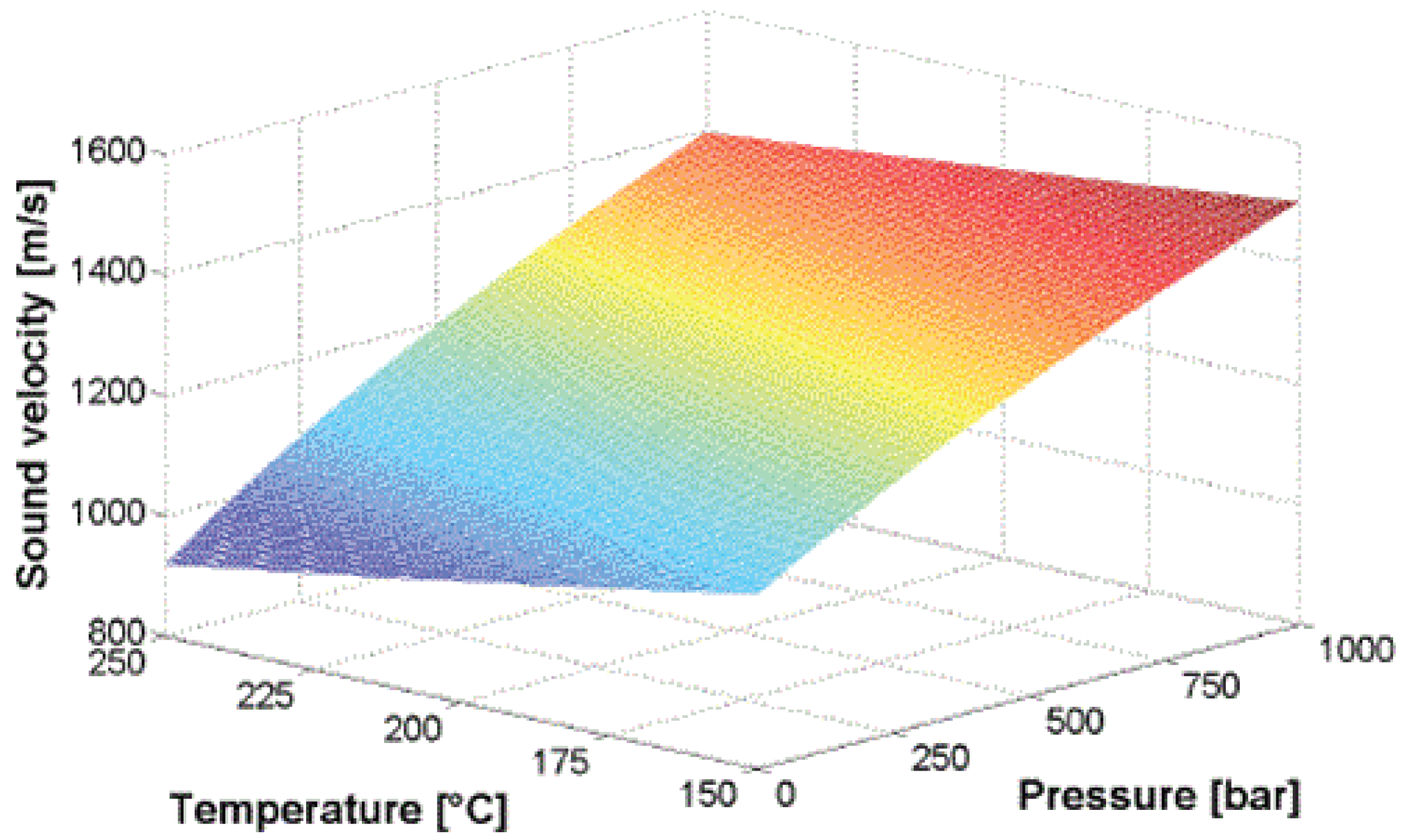

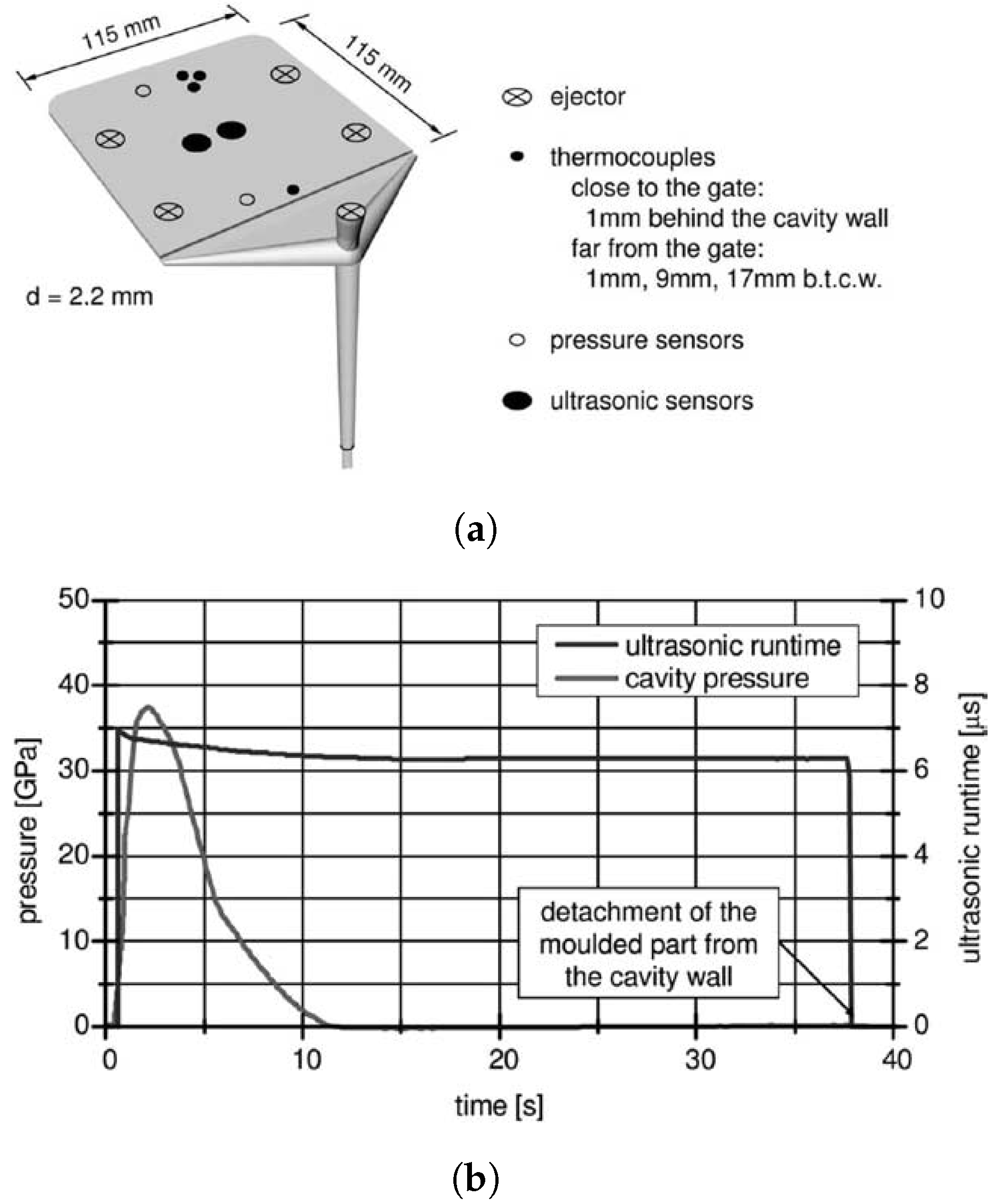



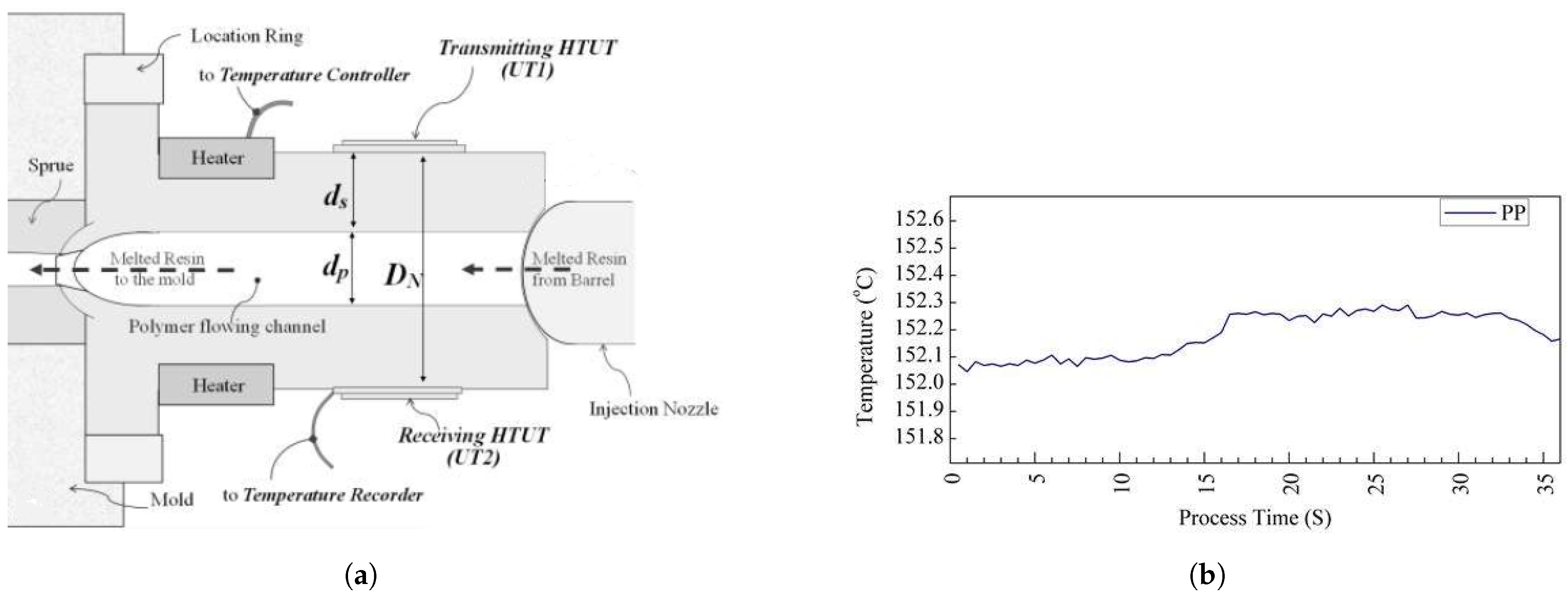
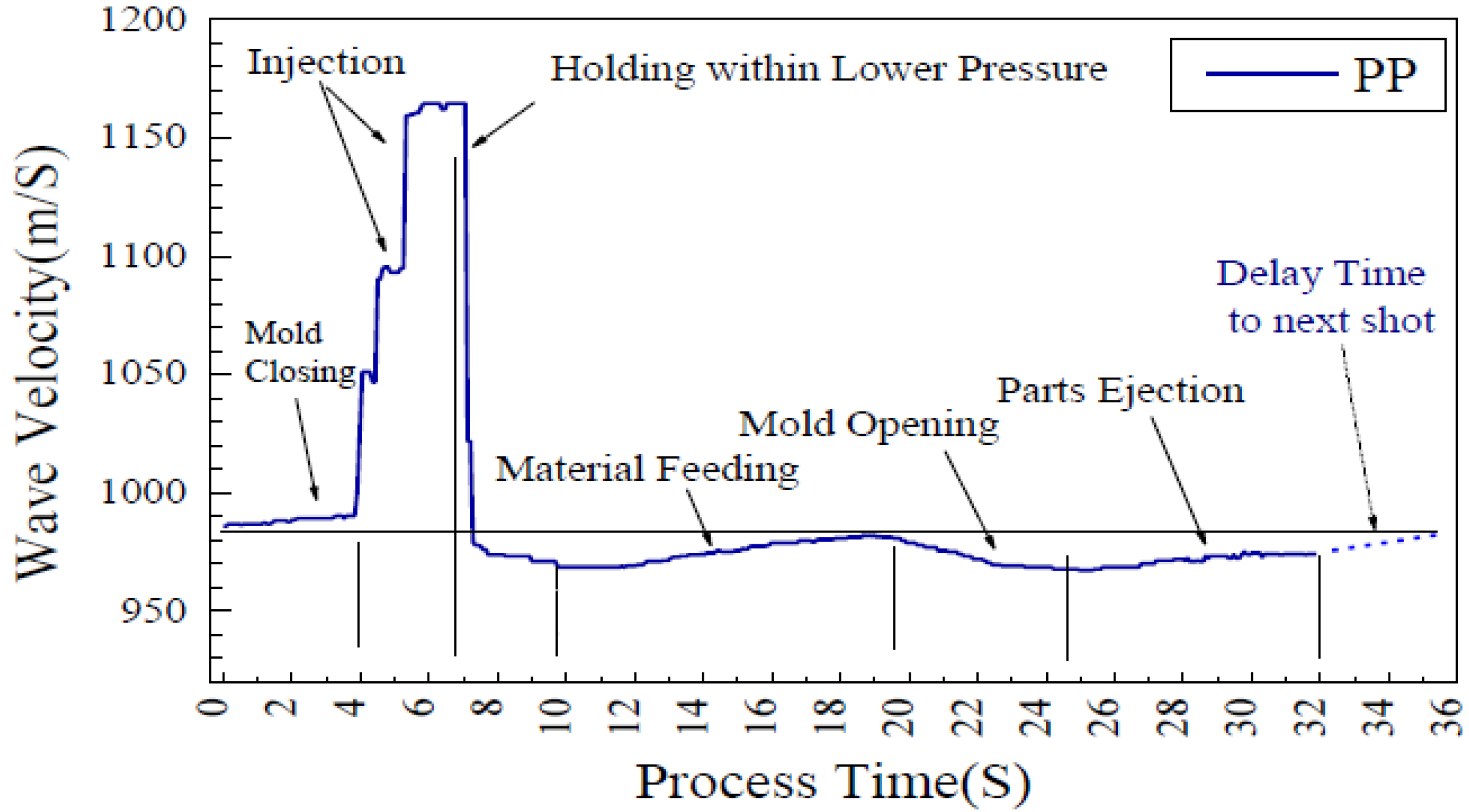

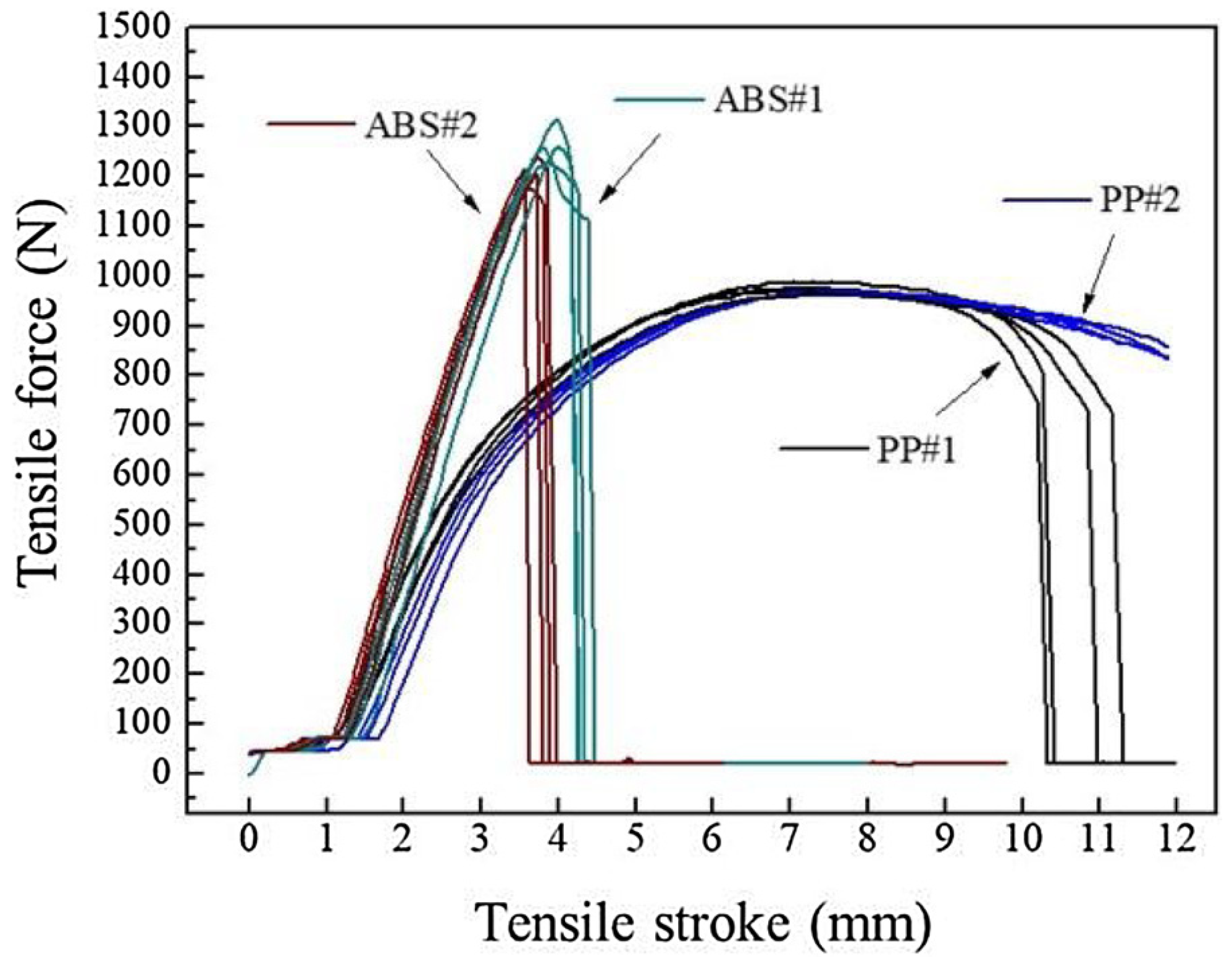
| Equation Number | Measured Ultrasonic Properties | Related Material Properties | Reference |
|---|---|---|---|
| (1)–(4) | Longitudinal Ultrasonic Velocity | 1. Bulk Moduli | [21,22,23] |
| 2. Density | |||
| 3. Pressure & Temperature | |||
| (5)–(6) | Velocity of Longitudinal & Shear Waves | 1. Density | [24] |
| 2. Wavelength | |||
| 3. Attenuation | |||
| 4. Ultrasonic Velocity | |||
| (7)–(9) | Reflection & Transmission Coefficient | 1. Number of mediums | [25] |
| 2. Acoustic Impedance | |||
| 3. Density | |||
| 4. Wave velocity | |||
| (10) | Longitudinal Ultrasonic Velocity in solid | 1. Young’s Modulus | [19] |
| 2. Poison’s Ratio | |||
| 3. Material Density | |||
| (11) | Ultrasonic Velocity of two echoes through melt | 1. Thickness of Sample | [19] |
| 2. Echo time | |||
| (12) | Ultrasonic attenuation of two echoes through melt | 1. Sample thickness | [19] |
| 2. Amplitude of signals | |||
| (13) | Ultrasonic Velocity in the tie bar of injection moulding | 1. The stress of tie bar | [26,27] |
| 2. The density of tie bar | |||
| 3. Lamé and Murnaghan constants of the material |
| Sol-Gel Composite Material | Center Frequency (MHz) | Temperature-Durability (°C) | −6 dB Bandwidth (%-MHz) | Film Thickness (µm) | Composite Type | Reference |
|---|---|---|---|---|---|---|
| PZT/PZT | 17–160 | 380 | 16–52% | 11–25 | Lead-based | [58,59,60] |
| BiT/PZT | 8–13 | 600 | 6–8 MHz | - | Lead-based | [53,61] |
| CaBiT/PZT | 6.3 | 600 | - | 50 | Lead-based | [62] |
| PMN/PT | 82 | - | 65% | 30 | Lead-based | [63] |
| PT/BT | 32 | 300 | 18 MHz | 60 | Lead-based | [64] |
| KNN/BNT | 170–320 | 320 | 34–64% | 6 | Lead-free | [65,66] |
| BNT | 98 | 320 | 84% | 11 | Lead-free | [67] |
| BiT/BiT | - | 600 | - | 50 | Lead-free | [68] |
| CBiT/BiT | 6.5 | 600 | - | 50 | Lead-free | [62] |
| CBiT/BST | 24.9 | 600 | - | 50 | Lead-free | [62] |
| BiT/TiO2 | 10.9 | 450 | 4.10% | 100 | Lead-free | [69] |
| BiT/ST | - | 500 | - | 100 | Lead-free | [70] |
| LN/BiT | - | 700 | - | 50 | Lead-free | [71] |
Publisher’s Note: MDPI stays neutral with regard to jurisdictional claims in published maps and institutional affiliations. |
© 2021 by the authors. Licensee MDPI, Basel, Switzerland. This article is an open access article distributed under the terms and conditions of the Creative Commons Attribution (CC BY) license (https://creativecommons.org/licenses/by/4.0/).
Share and Cite
Kariminejad, M.; Tormey, D.; Huq, S.; Morrison, J.; McAfee, M. Ultrasound Sensors for Process Monitoring in Injection Moulding. Sensors 2021, 21, 5193. https://doi.org/10.3390/s21155193
Kariminejad M, Tormey D, Huq S, Morrison J, McAfee M. Ultrasound Sensors for Process Monitoring in Injection Moulding. Sensors. 2021; 21(15):5193. https://doi.org/10.3390/s21155193
Chicago/Turabian StyleKariminejad, Mandana, David Tormey, Saif Huq, Jim Morrison, and Marion McAfee. 2021. "Ultrasound Sensors for Process Monitoring in Injection Moulding" Sensors 21, no. 15: 5193. https://doi.org/10.3390/s21155193
APA StyleKariminejad, M., Tormey, D., Huq, S., Morrison, J., & McAfee, M. (2021). Ultrasound Sensors for Process Monitoring in Injection Moulding. Sensors, 21(15), 5193. https://doi.org/10.3390/s21155193







